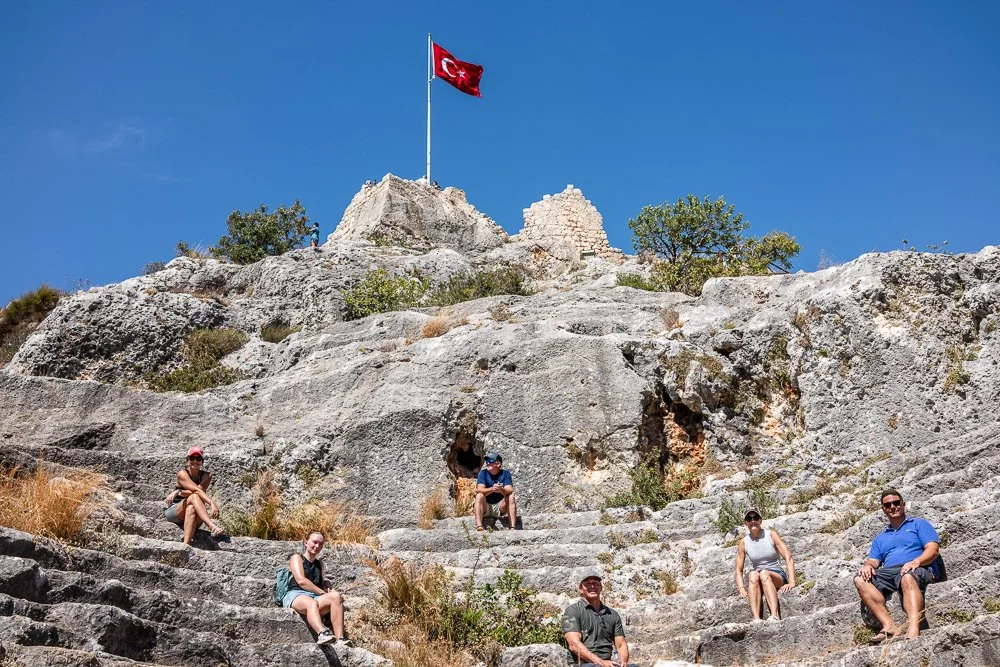Thursday: Pirates, tourists and tomb raiders.
I’ve always been fascinated by things that are old. Old houses, old cars, anything historic. I live in a house built in 1859. I drive a car built in 1929. I threw an archaeology party last year, where I invited a group of friends to dig a trench through the pre-Victorian era trash dump in my backyard. We found some cool stuff, like old bottles and coins. I was elated. My friends mostly got blisters and asked for another cocktail.
Natalie relaxes before our morning swim.
There are a couple of little islands here at the entrance to the bay formed between Kekova and the mainland. Between them the sea is about 15 feet deep, gin-clear, and full of schools of little fish. We plotted a figure 8 around the islands, and saw turtles, trumpet fish, squid, colorful little jellyfish and a way too playful remora.
As we rounded the second island, we came to a little bay with Lycean ruins just on shore. Neatly stacked rectangular stones, lintels, doorways. We swam around to the opposite side, and spied more of the same. A few of us climbed out to investigate. We saw columns, decorative plinths, circular walls, doorways and windows. This was obviously an important place back in oh say….. 300 B.C. What a privilege to walk among the ghosts of past civilizations. Standing among the ruins, I could sense them. Also, I wish I had sneakers, the rocks here are wicked sharp.
Jane was kind enough to take my goPro ashore with her as I don’t do well on land and stayed in the water. She got some GREAT photographs of the Lycean ruins, along with a few utterly charming totally inadvertent selfies. If my mistaken selfies looked this good I’d make them more often. Thanks, Jane! xx - HP
Back aboard our Gulet La Mia Stella, we gobbled down a quick snack of cold Turkish pizza, and sailed downwind to Simena Castle. Just opposite the sunken city of Kekova, this place also seems to have played an important role in the region, and still does, in the form of tourist activity. Inscriptions in the area date to around 400 B.C., and the “modern” castle itself was built in the Byzantine era (oh let’s say 250 A.D.) to fend off pirates. There's a bunch of Lycian tombs, mosaics, and a tiny amphitheater carved into the bedrock. There’s a whole village here that caters to the tourist Gulets that arrive here by the dozens every day, little ice cream shops and trinket sellers and cafes. There are ancient building materials strewn about and re-purposed. There’s a sarcophagus sticking out of the bay, reminding us that the land here has dropped at least a dozen feet in the last 2,000 years or so due to seismic activity. The devout and the bikini clad climb the same steps and take in the same view, all enjoying a fig ice cream and maybe a beer or a fresh squeezed orange juice. If this is a tourist trap, don’t release me.
We spent some time trying to find the right spot for this big Gulet to spend the night, and finally settled in a calm little bay in sight of the castle. A lazy swim merged into cocktail time.
Kevin got this lovely shot of our dramatic moon rise tonight.
Simon came up with the name for tonight’s poison.
The Lycean Tomb Raider:
1 part Vodka
1 part Campari
1 part orange juice
½ part lemon juice
Splash of soda water
Combine all ingredients except soda water in a pitcher and pour into whatever fancy glass you have over ice. Top with soda water. Now think about life in 300 B.C.
A mixed grill for dinner with some type of eggplant and yogurt dish that wowed everyone. Amy just had a big birthday, so a cake. Wine flowed. A red moon rose. Conversations drifted from stroke technique to otters. This group is so completely comfortable with each other, and when we say “sleep well I can’t wait to swim with you tomorrow”, we mean it.
Hopper
A little video recap of our morning swim!






































